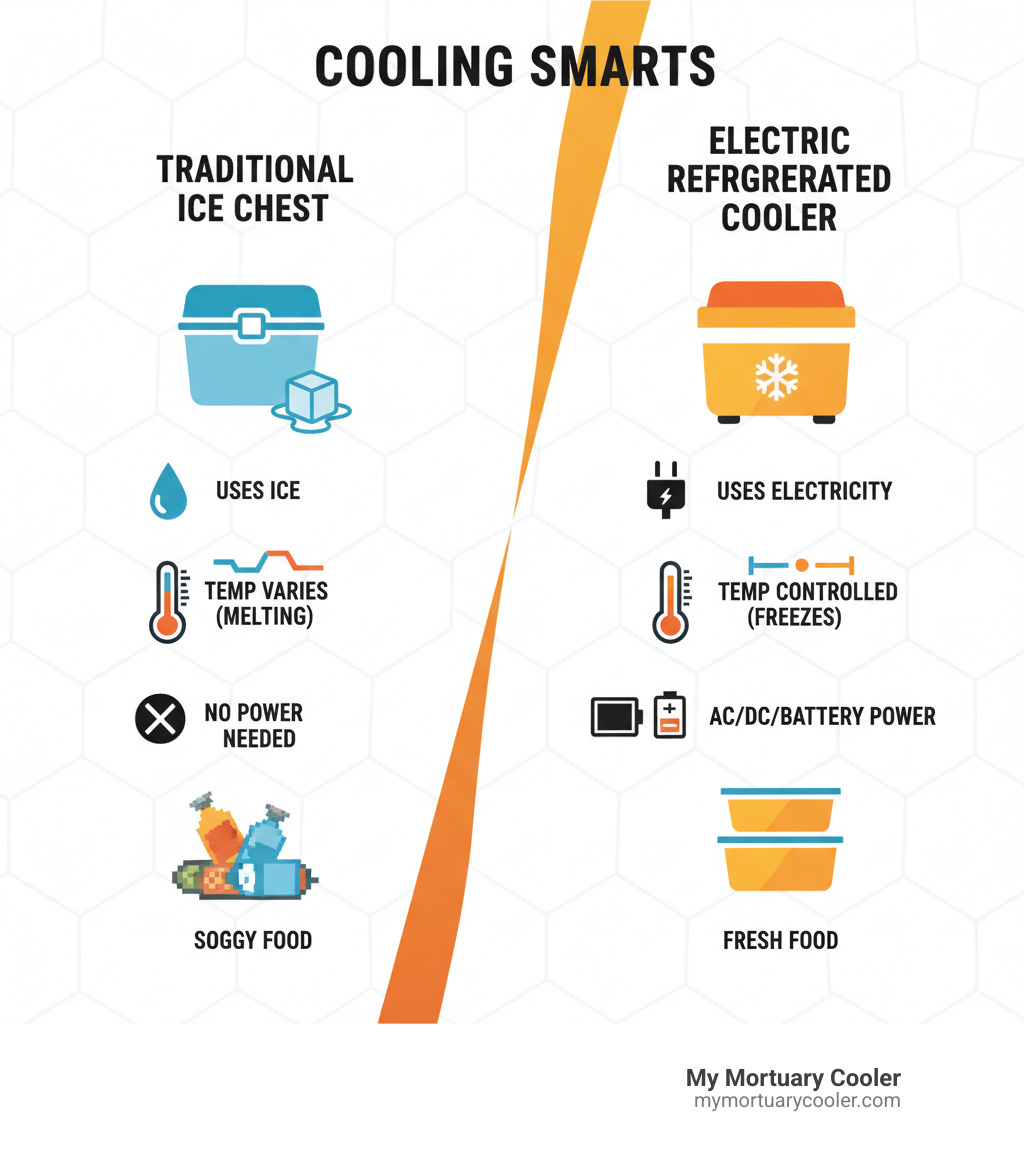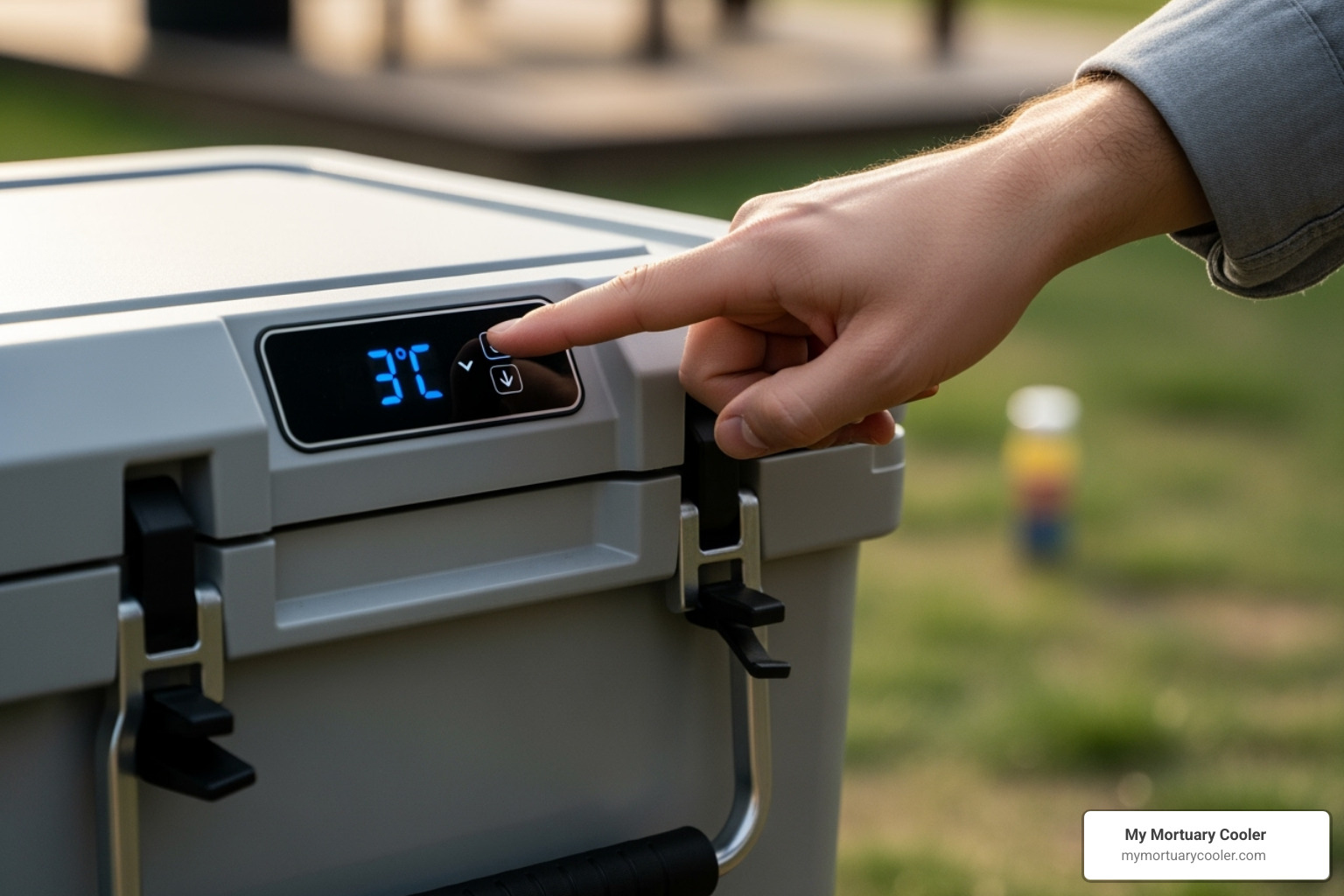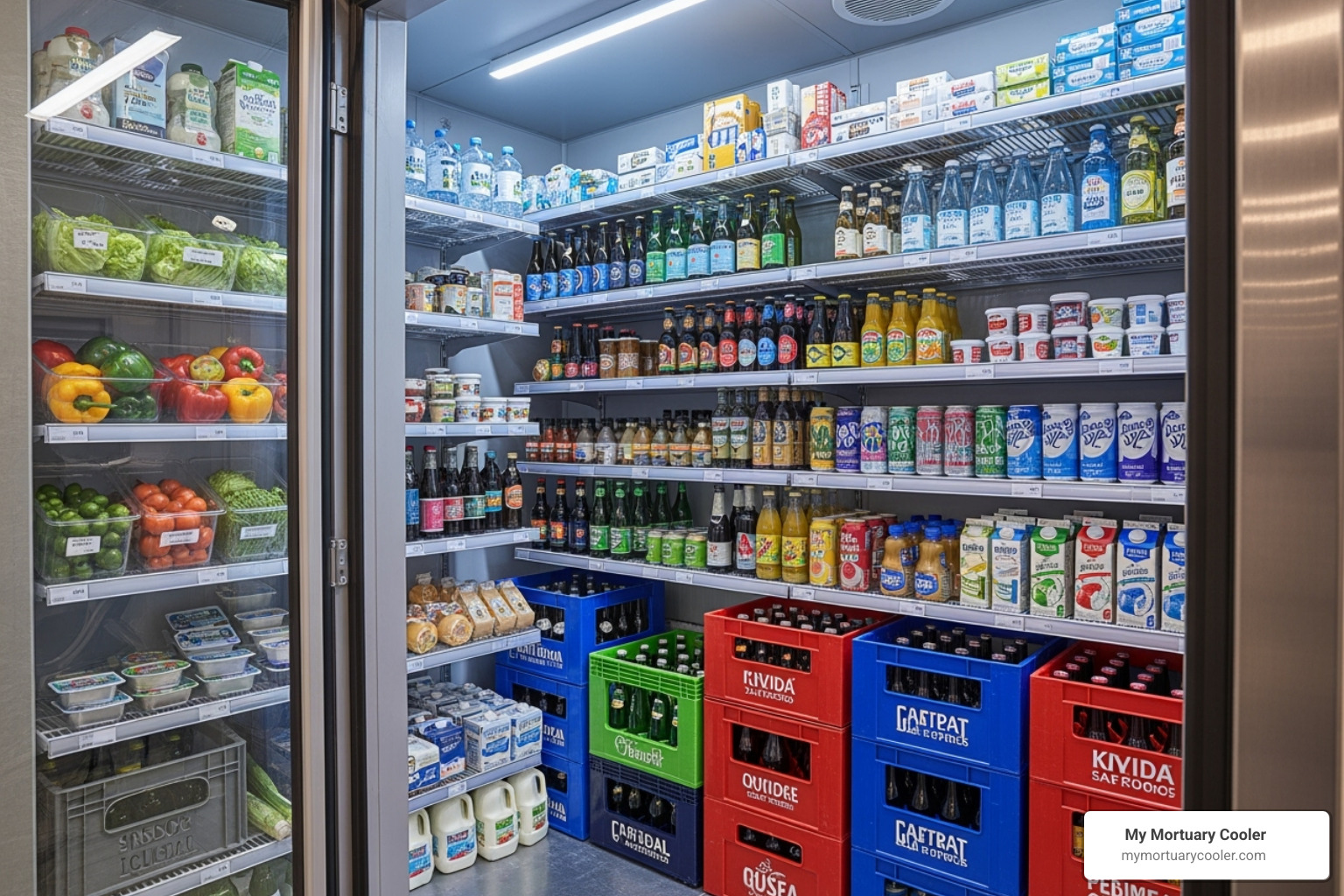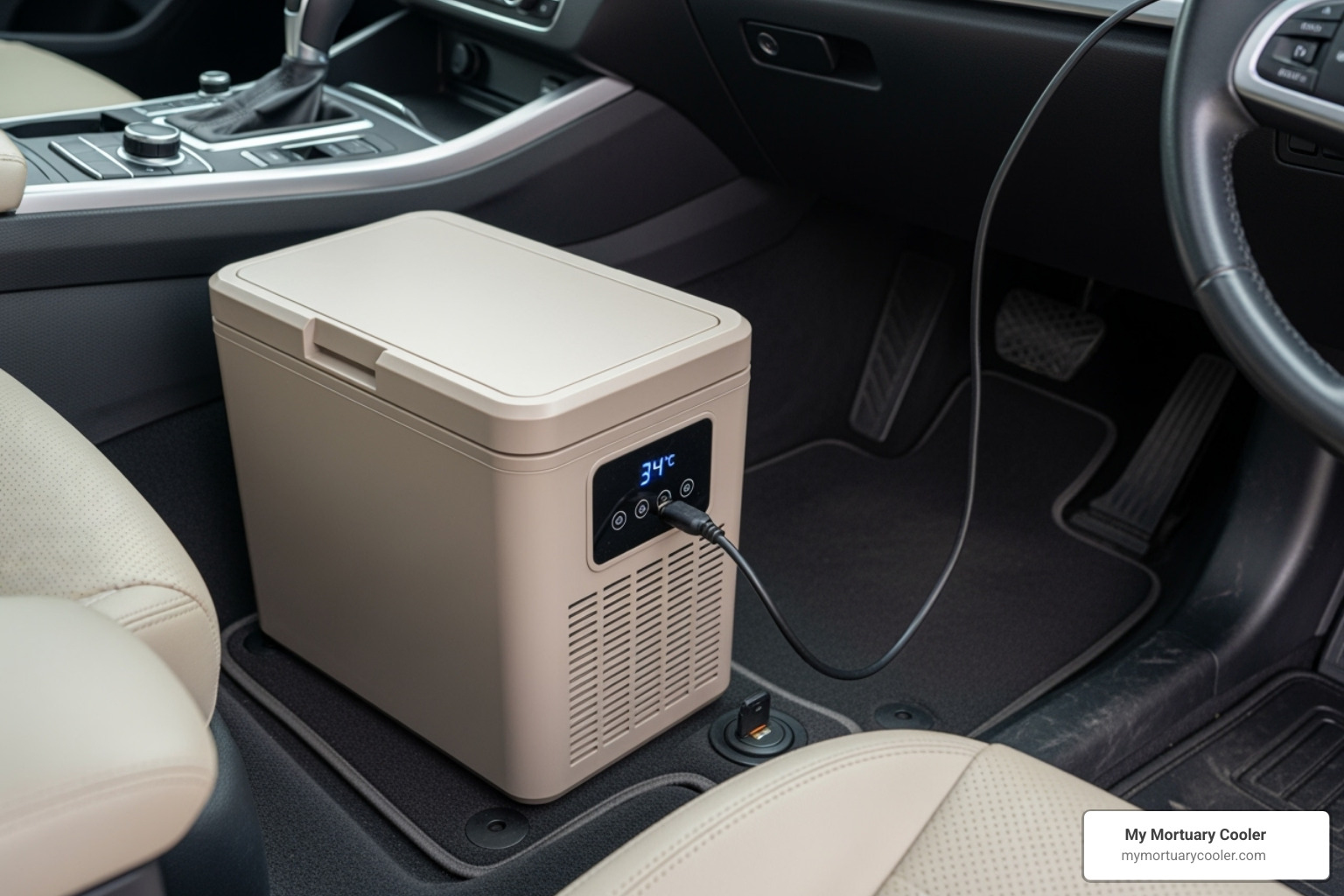Understanding Refrigerated Coolers
A refrigerated cooler offers a modern, efficient way to keep items cold without the need for ice. Unlike traditional ice chests, these units use electricity to maintain consistent temperatures, making them ideal for everything from road trips to specialized professional applications.
Here's a quick look at what a refrigerated cooler is:
- Ice-Free Cooling: Uses electricity to cool, eliminating the mess and inconvenience of ice.
- Consistent Temperatures: Can hold a set temperature, often below freezing, like a home refrigerator.
- Versatile Power: Can run on AC power (wall outlet), DC power (car outlet), or portable battery packs.
- Wide Applications: Suitable for consumer use (camping, road trips) and professional needs (medical, food service, mortuary).
Gone are the days of soggy food and constant ice runs. Refrigerated coolers provide a reliable solution for keeping perishables safe and drinks chilled. They are a significant upgrade, offering convenience and precise temperature control that traditional ice chests simply cannot match.

Types of Refrigerated Coolers: A Closer Look
When we talk about refrigerated cooler technology, it's helpful to know that there are two main families: thermoelectric and compressor-based. Understanding the fundamental differences between these cooling methods is super important! It's how you'll pick the perfect unit for your adventures or professional needs. Each type has its own special strengths and a few things to keep in mind, especially when it comes to how well they cool, if the outside temperature matters, and if they can freeze things or even keep them warm.
Thermoelectric Coolers
Think of thermoelectric coolers, sometimes called electric coolers or Peltier coolers, as the simpler, more budget-friendly option. They work using a neat trick called the Peltier effect. This means they have almost no moving parts (just a fan!), which makes them quieter and lighter than their fancier cousins.
How do they work? Basically, an electric current passes through two different materials, creating a cold side and a hot side. The fan helps push the heat away, leaving the inside of your cooler nice and chilly.
Now, for their cooling superpowers: our research shows that these units can typically cool items to about 20-40 b0F below the outside ambient temperature. So, if it's 80 b0F outside, your cooler might get down to 40-60 b0F. Some models might push that a bit further.
A big thing to remember is their dependence on outside temperature. If it's super hot outside, these coolers will struggle to keep things truly cold. This means they aren't the best choice for keeping perishable foods perfectly safe, especially in warm climates. They generally cannot reach freezing temperatures.
However, they do have a cool trick up their sleeve: many models offer a heating function! This is super handy for keeping casseroles warm for a potluck or transporting hot meals. They are typically lower cost (often around $100) and lighter weight, making them a great portable option for shorter trips.
These coolers are best for keeping already-chilled items cool or maintaining the temperature of things that don't need to be super cold. They're not ideal for serious food preservation, but for personal items like cosmetics or medication in small, personal coolers, they're perfect!
Compressor-Based Coolers
Now, let's talk about the heavy hitters: compressor-based coolers. You might hear them called car refrigerators or portable freezers. These units work much like the full-sized refrigerator in your kitchen!
How do they work? A compressor squeezes a special liquid called refrigerant. This liquid then flows through coils, releasing heat. It then expands into an evaporator coil inside the cooler, soaking up heat from the interior and making it wonderfully cold. This is the vapor-compression refrigeration cycle.
These powerhouses offer precise temperature control and can maintain a set temperature no matter how hot or cold it is outside. This is a huge plus! They can consistently reach and hold temperatures similar to a home refrigerator and, here's the best part, they can freeze food. Some models can reach 6 b0F, while others can even plunge to an impressive -8.5 b0F! Certain units show incredible accuracy, holding a set temperature with less than a degree of variance.
While they might use more power to get to their target temperature initially, their excellent insulation and ability to cycle on and off (just like your home fridge) often make them more energy efficient for keeping things cold over a long period. These coolers do come with a higher cost, typically starting around $200 and going up from there. They are also generally heavier and a bit bulkier because of their internal parts and strong insulation.
Compressor-based refrigerated coolers are ideal for perishables and long trips. They are truly indispensable for safely storing food, drinks, and even frozen items on long road trips, camping adventures, or in professional settings where precise temperature control is absolutely critical. As one happy user put it, they are "amazeballs" for serious food preservation!
Key Features to Consider When Choosing a Refrigerated Cooler
Picking the perfect refrigerated cooler goes way beyond just choosing between thermoelectric and compressor models. You need to think about your real-world needs – how you'll actually use it, where you'll get power, and which features will genuinely make your life easier. Let's walk through what really matters.

Capacity and Portability
The size of your adventures will determine what size cooler makes sense for you. It's not just about internal volume – though that's measured in quarts or liters and gives you a good starting point. A 20-liter model works great for a couple on a weekend getaway, while you might need something like a 55-liter unit or even an 80-quart model for tailgating with a crowd.
Here's the thing about external dimensions – compressor coolers can be surprisingly bulky on the outside even when their storage space seems reasonable. All that insulation and those internal components take up room. Always measure your car's cargo area before you buy.
Weight becomes crucial if you'll be moving your cooler around frequently. Thermoelectric models win on portability, but some compressor units come with thoughtful features like sturdy handles or built-in wheels that make transport much easier. A compact 23-quart model is perfect if you're working with a small car or tight storage space.
Think about trip length and group size too. How many cans do you actually need to fit? Are you feeding two people for a day or a family for a week?
Power Options and Energy Consumption
How you'll power your refrigerated cooler can make or break your experience. Most units offer flexibility with AC wall outlets for home use, 12V DC car outlets for road trips, and compatibility with portable power stations for off-grid adventures. Some advanced models can even run on solar panels – talk about off-grid freedom!
Battery protection settings are absolutely crucial if you're using your car's power. Nobody wants to be stranded with a dead battery. Look for units with low-voltage cutoff features that automatically shut down when your car's battery gets too low. This simple feature can save you from an expensive tow truck call.
Energy efficiency ratings matter more than you might think. A highly efficient model shows what's possible – drawing just 5.8 watts per hour on average and keeping 65 cans at 36°F for around 32 hours in 78°F weather with its detachable battery.
Temperature Control and Performance
This is where your refrigerated cooler either delivers on its promises or lets you down completely. Digital thermostats on compressor-based units give you the precision you expect – set an exact temperature just like your home refrigerator. Some models even offer app control, so you can check on your cooler from your smartphone and adjust settings without getting up.
Cooling speed can be a game-changer, especially when you're loading up for a trip. Some models are impressively quick, hitting 38°F in about 20 minutes. That means less waiting around and more confidence that your food will stay safe.
Insulation quality affects everything else – how efficiently your cooler runs, how long your battery lasts, and how well it maintains set temperature regardless of ambient conditions. Good insulation means your compressor doesn't have to work as hard, saving energy and extending the life of your power source.
Consider your temperature range needs carefully. Do you need just refrigeration, or do you want freezing capability too? Compressor units excel here, offering everything from deep freezing to standard refrigeration temperatures. The difference between a cooler that can freeze and one that can't might determine whether you can bring frozen treats on your camping trip or stick to shelf-stable snacks.
Beyond Portability: Large-Scale Refrigerated Cooler Solutions
While those handy portable refrigerated cooler units are perfect for our personal adventures and smaller needs, controlled cold storage really expands when we look at commercial and specialized industrial requirements. Here, we're talking about stepping into the field of professional-grade refrigeration – a whole different ballgame!

Walk-In Coolers
Imagine a refrigerator you can actually walk into. That's essentially what a walk-in cooler is! These are robust, permanent, or semi-permanent installations designed for seriously high-capacity cold storage. They offer capabilities far beyond what any portable unit could ever hope to achieve.
These units are built to store vast amounts of perishable goods, making them absolutely essential across a wide range of industries. Think about it: hunters need them for game storage, breweries rely on them to keep their temperature-sensitive products just right, florists depend on them to keep delicate blooms fresh and vibrant, and food service establishments use them for bulk food storage, ensuring everything stays safe and delicious.
Unlike their smaller, portable cousins, walk-in coolers offer incredible customization. You're not just getting a box; you can get specialized shelving, advanced meat rail systems, various door sizes, and even remote refrigeration systems to fit unique building layouts. Companies like ours at My Mortuary Cooler specialize in providing professional-grade, OSHA-compliant solutions that are custom-custom to diverse and demanding needs.
Modern walk-in coolers also put a big focus on energy efficiency. They often feature advanced insulation and cutting-edge refrigeration technology to keep operating costs down. In fact, some innovative systems can significantly reduce upfront costs by allowing standard air conditioners to function as walk-in cooler units. This clever approach can cut initial expenses and operating costs compared to some traditional systems. It's even being used to help small farmers prevent food spoilage!
Beyond general commercial use, walk-in coolers play a critical role in highly specialized fields. In healthcare, for instance, they provide essential refrigeration for hospitals, blood centers, and special care facilities. And in the funeral industry, our company, My Mortuary Cooler, provides advanced mortuary refrigeration solutions. These ensure precise temperature control for sensitive applications, offering peace of mind and upholding the highest standards of care.
For a deeper dive into these professional-grade solutions, especially those custom-designed for the mortuary industry, we invite you to explore More info about professional-grade walk-in coolers.
Powering and Maintaining Your Refrigerated Cooler
Owning a refrigerated cooler truly open ups a new level of freedom and convenience for your adventures, whether it's a weekend camping trip or a long haul. But to make sure your chilly companion serves you well for years to come, it's super important to understand how to power it smartly and keep it in tip-top shape. Think of it as giving your cooler a little love and attention!

Power Requirements and Preventing Battery Drain
The best part about a portable electric cooler is its go-anywhere power options. You can plug it into a regular wall outlet at home, or use your car's 12V port while on the road. But this flexibility also means we need to be a little clever about how we power it up to avoid any unexpected hiccups.
One common worry is draining your car's battery, especially if you're parked for a while with the engine off. Nobody wants to be stranded with a dead battery just because their snacks were kept perfectly cold! Thankfully, most good quality 12V car refrigerators are pretty smart. They come with a low-voltage cutoff feature that acts like a guardian for your car's battery. This system watches your battery level and will gently switch off the cooler before it dips too low, leaving you enough juice to start your engine. Some models even give you a friendly "low voltage" alert beforehand.
For those longer stops or off-grid adventures where you won't be running your car, we highly recommend bringing along a portable power station or a dedicated secondary battery. These act as independent power sources, giving your refrigerated cooler all the energy it needs without touching your car's starting battery. For instance, some models even have a built-in detachable battery, which is super handy for going truly untethered!
Here's a pro tip for making your cooler extra efficient: "prime" it before you hit the road. The night before your trip, plug your refrigerated cooler into a standard wall outlet at home. Let it cool down to your desired temperature while it's using easy-to-access AC power. Then, load it up with items that are already chilled. This way, when you switch to car power, your cooler just has to maintain the cold, which uses far less energy than trying to cool everything down from warm. It's a simple step that makes a big difference in power savings!
Care and Maintenance Tips for Your Refrigerated Cooler
Just like any good appliance, a little tender loving care goes a long way in ensuring your refrigerated cooler remains a reliable partner for countless adventures. Keeping it well-maintained helps it perform its best and live a long, happy life!
First things first, regular cleaning is a must. Just like your home fridge, the inside of your portable cooler can get a little messy. Use some mild soap and water to wipe it down, which helps prevent odors and keeps things hygienic. Make sure it's completely dry before you close it up for storage.
Next, for compressor-based models, ensuring proper ventilation is crucial. The compressor needs to "breathe" and release heat. So, always check that the vents aren't blocked, especially if your cooler is tucked away in a tight spot like a car trunk or a storage box. Good airflow means a happy, efficient cooler!
Don't forget to check the seals around the lid. These rubber gaskets are super important for keeping the cold air in and the warm air out. Give them a quick look now and then for any cracks or damage, and keep them clean to ensure a nice, tight seal. A good seal equals better efficiency and colder contents.
When your adventures are over and the cooler isn't in use, it's best to store it properly. Find a dry, well-ventilated spot, and here's a trick: leave the lid slightly ajar. This prevents any funky smells or mildew from growing inside.
Finally, while these units are built to be pretty tough, it's always wise to handle your refrigerated cooler with care. Try to avoid dropping it or placing really heavy items on top, which could damage its internal workings or sturdy exterior. A little care means a lot more happy memories with your trusty cooler!
Frequently Asked Questions about Refrigerated Coolers
We get tons of questions about refrigerated cooler technology from folks who are curious about making the switch from traditional ice chests. Let's explore the most common ones—chances are, you're wondering about some of these same things!
Can electric coolers freeze food?
This is probably the biggest question we hear, and the answer depends entirely on which type of refrigerated cooler you choose.
Compressor models are freezing champions! These units work just like your home refrigerator and can absolutely freeze food solid. They're the real deal when it comes to maintaining freezing temperatures, often reaching well below 0°F. Need to keep ice cream frozen on a road trip or preserve your fresh catch from a fishing expedition? A compressor-based unit has you covered. We've seen some models hit 6°F, while others can plunge to an impressive -8.5°F.
Thermoelectric models, on the other hand, are cooling-only units. They simply can't reach freezing temperatures because they're limited to cooling about 20-30°F below whatever the outside temperature is. So if it's 80°F outside, your thermoelectric cooler will only get down to around 50-60°F—not nearly cold enough for freezing, and potentially too warm for safe food storage on hot days.
How long can I run a cooler on my car battery?
This is a smart question because nobody wants to be stranded with a dead battery! The answer varies based on several key factors.
Your cooler's efficiency plays a huge role. Compressor models are actually pretty smart—once they reach your target temperature, they cycle on and off just like your home fridge, which saves power. Your car battery's size and age matter too. A newer, larger battery will obviously last longer than an older, smaller one.
The outside temperature affects runtime as well. When it's blazing hot, your refrigerated cooler works overtime, drawing more power to maintain cool temperatures.
Here's the good news: most quality 12V car refrigerators come with built-in low-voltage protection. This clever feature monitors your car's battery and automatically shuts off the cooler before it completely drains your battery, ensuring you can still start your vehicle.
For typical use, many folks can run their compressor fridges for 3-4 hours with the engine off. But for longer adventures—like overnight camping—we strongly recommend investing in a portable power station or a dedicated deep-cycle battery. A highly efficient model, for example, can keep 65 cans chilled at 36°F for around 32 hours when unplugged, thanks to its built-in battery system.
Is a refrigerated cooler worth the investment?
This really depends on how you plan to use it, but for many people, the answer is absolutely yes!
For occasional users who just need to keep a few drinks cool for short trips, a traditional ice chest might still do the trick. But if you're constantly buying bags of ice and dealing with soggy sandwiches, even a basic thermoelectric cooler around $100 could be worth it.
For frequent travelers, campers, and tailgaters, a compressor-based refrigerated cooler can be life-changing. Yes, they typically start around $200 and go up from there, but think about it—no more emergency ice runs, no more wondering if your food is safe to eat, and no more dealing with melted ice water everywhere. Many users tell us these units are "worth every penny" for the convenience and peace of mind alone.
For professionals, the investment becomes even more critical. Whether you're transporting medical supplies, catering an event, or working in specialized fields like our mortuary refrigeration services, precise temperature control isn't just convenient—it's absolutely essential. The ability to maintain exact temperatures for sensitive materials makes the investment invaluable.
The bottom line? If you prioritize food safety, hate dealing with ice, and value consistent cooling performance, a refrigerated cooler delivers significant value that often pays for itself in convenience and long-term savings.
Conclusion
We've taken quite a journey together through refrigerated cooler technology! From understanding the basic differences between thermoelectric and compressor units to diving deep into power requirements and maintenance tips, we've covered everything you need to make an informed decision.
The beauty of modern refrigerated cooling is that there's truly something for everyone. If you're just looking for a budget-friendly way to keep drinks cool on weekend trips, a thermoelectric cooler around $100 might be perfect. Need something more serious? Compressor-based units deliver restaurant-quality refrigeration and freezing capabilities that make them worth every penny for frequent travelers, campers, and anyone who takes food safety seriously.
And let's not forget the professional-grade solutions we discussed. From hunters storing their game to breweries maintaining perfect temperatures, walk-in coolers represent the ultimate in cold storage technology. In specialized fields like healthcare and mortuary services, precise temperature control isn't just convenient—it's absolutely critical.
Matching your cooler to your actual needs is what makes all the difference. A weekend warrior needs different features than someone hauling perishables across the country. A florist has different requirements than a funeral director. The key is being honest about how you'll really use your cooler.
At My Mortuary Cooler, we understand that when precision matters most, there's no room for compromise. Our OSHA-compliant, professional-grade solutions serve those who demand the absolute best in critical applications. Whether you're just starting to explore refrigerated cooling or you need the most advanced mortuary refrigeration available, the right solution is out there.
For those ready to explore the most rigorous professional cold storage options, we invite you to check out The Ultimate Guide to Walk-in Mortuary Coolers and Products. Because when it comes to preserving what matters most, you deserve equipment you can trust completely.
















